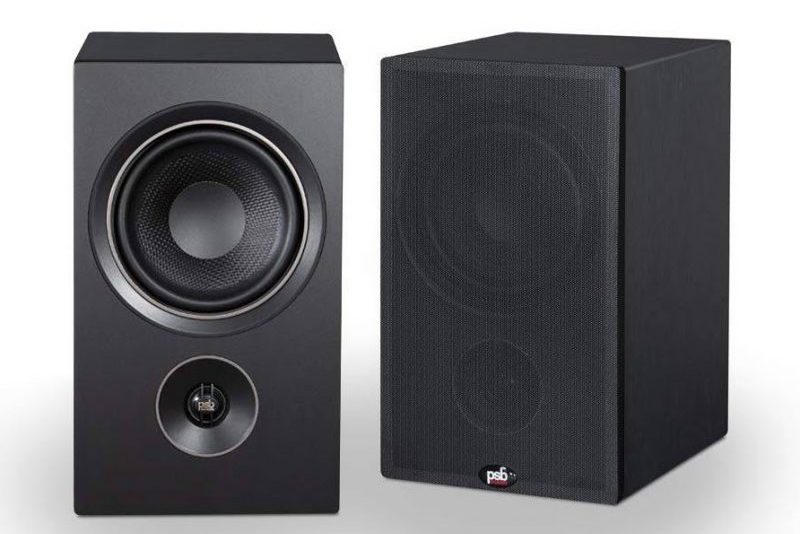PSB Speakers first released their entry-level Alpha series back in 1991, and from the beginning, they aimed to deliver remarkable value and performance. Based on the stellar reviews, I’d have to say they succeeded. This year at CES 2019, they announced an all-new Alpha series redesigned from the ground up, with brand new drivers, cabinets, and crossovers.
There are Four models in all, comprised of two compact monitors P3 ($199 per pair) and P5 ($349 per pair), a center channel C10 ($299 each) and a tower model T20 ($599 per pair). All four models are available in a choice of Walnut or Black Ash finishes. The model I’m reviewing today is the Alpha P5, the larger of the two monitors in the line.

Build/Features
The P5 is a two-way bass-reflex design with a custom 5.25” woofer, and 0.75” black anodized aluminum dome tweeter. The midbass/woofer is crafted from textured polypropylene with a rubber surround and employs a dual-layer voice coil to provide greater control at higher output levels. The textured cone is said to minimize cone breakup and reduce distortion.
The tweeters employ ferrofluid cooling and a neodymium magnet which is known for high sensitivity. The tweeter’s front waveguide and atypical placement below the woofer work together to maximize both on and off-axis performance. These speakers also use a new crossover developed just for the Alpha Series.

The cabinet is said to have a unique combination of wall thickness and bracing to control resonances and the internal damping material is stated to be from PSB’s flagship lines. They are Finished with a wood grain vinyl and magnetically attached, acoustically transparent, wafer-thin metal grilles. The rounded edges and copper accents on the front panel around the drivers are the only stylish flourishes on what is otherwise a very spartan design. They are elegant in a simple way.
The port tube in this bass-reflex design is rear firing, so the P5 definitely do better out away from the wall. The tube design is carried over from the original Alpha model, and it is tuned well, providing very deep bass notes for a mini-monitor with minimal port chuff. Below the port are 5-Way, gold-plated binding posts.

Sound
I set the P5 on heavy metal speaker stands about 20 inches away from the wall behind them. I hooked them up to the 2 x 60w NAD D3045, an amp with a crisp, flat sound that lets high-quality speakers shine. I plugged in my HP Envy laptop to the NAD Asynchronous USB 24/192 input using an AudioQuest USB cable. I cued up some music from the TIDAL desktop app for the majority of my testing.
I found the image to be most focused when the speakers were toed in slightly…but the soundstage was a little bit wider when the speakers were pointed straight ahead. I did all of my tests with speakers toed in.
The overall sound of the Alpha P5 is warm and engaging, with a crisp, natural midrange, sweet highs, and nice weight to the low end. Bass is surprisingly deep and taut for a speaker of its size. I guess I shouldn’t be so surprised since the P5 is designed by Paul Barton, who also designed the Imagine Mini, a very small speaker which also produces an impressive amount of bass.
As a matter of fact, the Alpha P5 sound is very reminiscent of the PSB’s more expensive Imagine Series. The Alpha speaker is a little less transparent in the mids, and the bass on the Imagines is a little deeper and tighter, but they have the same overall warm sound, and big scale.
The soundstage of the P5 was deeper and taller in my space than it was wide. The imaging was really good with vocals staying focused in their own little bubbles. The only time things became compacted was on really complex passages with many elements. But most of the time, the separation was really good, providing a really credible performance for such a reasonably priced speaker.
One of my favorite test tracks is “La Flamenca Maria” by Jane Bunnett and Maqueque because of the fast rhythm and all the different voices and instruments that come together in the song. On a good pair of speakers, the four vocal solos not only sound like different people but they also appear in different locations across the soundstage. Same with the many instruments that are used in the band. The P5 did a really good job here, reproducing the different vocal textures with great accuracy for a speaker that sells for $350 pair. Same with the various instruments, like the congas and the güiro used by the lead singer.

Conclusion
The Alpha P5 has become my favorite speaker under $500. The sweet highs coupled with the engaging mids and weighty bass just draw you in, making for a very easy listening speaker that you can listen to for a long time. They also sound good with just about every genre. Comparing them to the competition, I think they give you liveliness and excitement of the ELAC Debut B 6.2 speakers, along with the detail and transparency of the Q Acoustics 3020i. They are like the best of both worlds. Just right. Highly recommended for a speaker under $500.
Buy Here: PSB Alpha P5 Bookshelf Speaker

I’m an audio writer who started as a young audio salesman/consumer electronics professional back in the late 90s. That’s where I discovered the magic of 2-Channel sound. My thirst for great sound has led me on a delightful music quest that continues today.



Leave a Reply